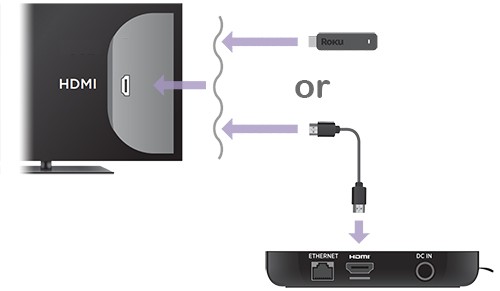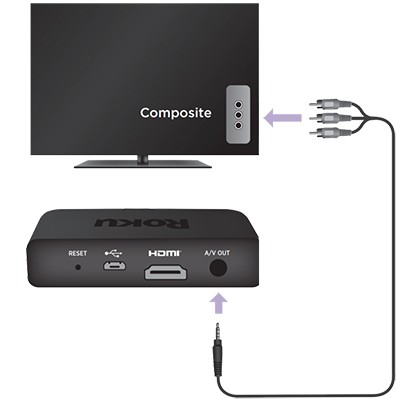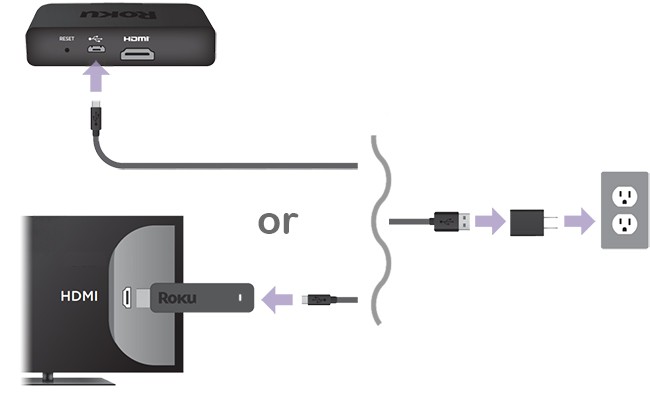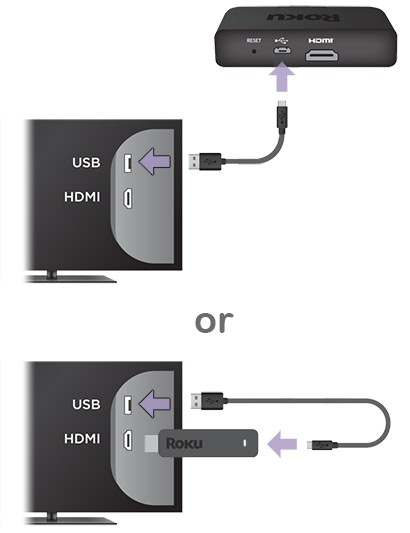How to set up your Roku streaming player or Streaming Stick (any model)
After you connect and power on your Roku® streaming player or Roku Streaming Stick®, the setup procedure for both devices is essentially the same. This document describes the basic setup instructions you can use for any Roku player or Streaming Stick. If you have a Roku TV system and need help, visit the dedicated setup article for setting up a Roku TV system.
Keep in mind that if your Roku player or Streaming Stick supports 4K Ultra HD (4K) or High Dynamic Range (HDR), you will not be able to take advantage of 4K without a 4K-compatible TV, or HDR without an HDR-compatible TV. In addition to a compatible TV, there are other requirements you should be aware of when setting up your Roku device for 4K or setting it up for HDR.
If you prefer a more tailored set of instructions, you can visit the setup article specific to the current-generation models listed below.
How to connect your Roku device to a TV
Your Roku streaming device can be connected to any television with an HDMI® port. To make this connection, a Roku player requires an HDMI cable while a Roku Streaming Stick connects directly with its built-in HDMI connector. When selecting an HDMI cable, we recommend that you use a High Speed HDMI Cable if your TV only supports 720p and 1080p, or a Premium High Speed HDMI Cable if your TV also supports 4K Ultra HD or HDR.
What if my TV does not have an HDMI port?
Current-generation Roku players must be connected to a TV with an HDMI port. However, if you have an older television that does not support HDMI and an older Roku player with a composite audio/video connection, you can connect your player to your TV to stream your favorite entertainment.
To determine if your player has a composite connection, look for a single port labeled "A/V" or "A/V OUT", or you may see a separate port labeled "VIDEO" along with two ports labeled "AUDIO". The cable you need to connect your player to your TV likely has red, white, and yellow connectors like those seen here.

Hook up your Roku device
Use the steps below to connect your Roku streaming player or Roku Streaming Stick and prepare it for on-screen setup and activation.
Connect your Roku device to your TV
- Using HDMI
Connect your Roku player using the correct HDMI cable, or connect your Streaming Stick directly

- Note: Your Roku player or Streaming Stick may differ from those depicted in the sample diagrams here.
If you plan to stream 4K or HDR content, you must connect your compatible Roku device to an HDMI input that supports HDCP 2.2. Learn what to look for if you need help identifying an HDMI input that supports HDCP 2.2.
- Note: If your Roku Streaming Stick does not easily connect to the HDMI input on your TV due to space restrictions, you may wish to get a free HDMI extender cable.
Using composite
If your TV does not have an HDMI port, connect your compatible Roku player using composite cables.

Connect your Roku player to your wired network (optional)
- If you are using a wired network and your Roku player has an Ethernet port, connect one end of an Ethernet cable to your player and the other end to an available Ethernet port on your router or network switch.

- Note:
- Some Roku players without an Ethernet port support a wired network connection using a compatible third-party Ethernet adapter.
- A Roku Streaming Stick does not have an Ethernet port.
- Note:
Connect your Roku device to power
- From a wall outlet (recommended)
Use the power adaptor (or USB power cable and power adaptor) to connect your Roku streaming device to a wall outlet.

- Note: If you are connecting a Roku Streaming Stick 4K or Roku Streaming Stick 4K+, you must connect the USB power cable with long-range Wi-Fi receiver to the power adaptor. For details, refer to the setup article that explains how to connect the long-range Wi-Fi receiver.
From a USB port on your TV
Any Roku Streaming Stick supports USB power, but only some Roku players do. If you are connecting your Roku device to USB power, use the USB power cable to connect it to a USB port on your TV.

- Note: The USB port on some TV’s may be unable to power a Roku device. If you see the on-screen warning message that appears in these cases, use the power adaptor (or USB power cable and power adaptor) and connect to a wall outlet.
Power on your TV and select the correct input
- Use your TV remote to power on your television and select the input where you connected your Roku device. You should see the Roku logo on the TV screen as your Roku device powers on. Help is available if you do not see any picture on your TV.
Set up your Roku remote
Depending on which Roku streaming player you have, it will come with one of two types of remote:
- Roku simple remote
- Roku voice remote
All Roku voice remotes have a voice button located near the purple directional pad that has either a microphone
 or magnifying glass
or magnifying glass  icon.
icon.
If your remote has a voice button, you have a Roku voice remote. If it does not, you have a Roku simple remote.

- Tip: If you still need help determining which remote you have, review the article with tips for identifying your Roku remote.
To set up a Roku simple remote, you only need to insert new matching batteries, or remove the battery pull tab, and point the remote at the front of your Roku device.
If you have a Roku voice remote, follow the on-screen setup instructions to pair your voice remote with your streaming device. Some voice remotes, like the Roku Voice Remote Pro, have a rechargeable lithium-ion battery. Other voice remotes use standard alkaline batteries just like a Roku simple remote.
- If your voice remote has batteries pre-installed and a battery pull-tab, pull the tab to power on the remote.
- If your voice remote does not come with batteries pre-installed, slide open the battery cover and insert fresh, matching batteries.
If you need more help with your remote, learn how to fix any issues with your Roku simple remote or how to set up and pair your Roku voice remote.
On-screen setup and activation
A welcome screen will appear after you switch your TV input to where your streaming device is connected. During setup, you will choose a language, connect to the internet, download the latest updates, configure display settings, and finally activate your Roku streaming device. You must create or use an existing Roku account and then activate and link your device using an activation link sent to your email or accessed with a QR code. Learn how to enable the text-to-speech screen reader, if you need audial assistance navigating through setup.
Choose a language
The first screen you see will allow you to choose a language. Scroll through the list and press OK  on your Roku remote to choose a language. All text and dialog within the Roku interface will be displayed in the selected language.
on your Roku remote to choose a language. All text and dialog within the Roku interface will be displayed in the selected language.
- Note: It is the responsibility of the channel publisher to translate their channel and some channels may not support your chosen language.
Connect to the internet
If you are using a wired network, make sure an Ethernet cable is connected to your Roku streaming device (if it has an Ethernet port) or a compatible Ethernet adapter (if your device has a USB or micro USB port and supports a third-party adapter) and select Wired. Otherwise, select Wireless and use the guidelines below to set up the wireless connection.
Choose your wireless network from the list of available networks and enter your password. This is often the same network you use to connect your computer or smartphone to the internet. If you do not see your network, select Scan again to see all networks. For more assistance, see help finding your wireless network and password.
If you want to see your password as you type, choose Show password. This can help prevent entering the wrong password. Remember, passwords are case-sensitive. Use the shift button  on the on-screen keyboard to enter a capital letter.
on the on-screen keyboard to enter a capital letter.
Once you enter your password and select Connect, your device will automatically connect to the internet. Alternatively, you can get more help if you are unable to connect to your wireless network.
Download the latest updates
Once connected to the internet, your streaming device will check to see if there is a software update available, download the latest version if necessary, and automatically reboot after updating.
Configure display settings
Select Set display type and let your streaming device auto detect the best display resolution so you do not have to manually configure the settings. To change the display type at a later time, go to Settings > Display type.
If support for 4K or HDR is not detected on your compatible Roku device, and you are using a compatible TV, make sure all HDMI cables are firmly attached and all connections support HDCP 2.2. For more help, review the steps for 4K setup or HDR setup.
- Note: This step may be done automatically by your device. If this step is not shown during setup, your device was able to do this step automatically for you.
Set up your Roku voice remote to control your TV
Select Check remote settings to automatically set up your Roku voice remote to control the power and volume for your TV. If you skip this step, you can set up your remote for TV control at any time from the Settings menu. Simply go to Settings > Remotes & devices > Remotes > [select your remote] > Set up remote for TV control. A Roku voice remote may not be able to control volume and power on all TV models. With some TV models, you may only be able to control the volume, and not the power.
- Note: This setup step only appears if you are using a Roku voice remote with TV controls. Certain Roku devices released in 2017 and later include this remote, or you can purchase one from the Roku accessories store.
Create a Roku account and activate your device
When prompted on screen, you will need to perform the following steps to create your Roku account and complete device activation. It may take a few moments to receive the activation email from Roku. If you do not see it in your email inbox, be sure to check your spam (or junk) folder.
- Press OK
 on your remote to reveal the on-screen keyboard.
on your remote to reveal the on-screen keyboard. - Using your remote, type a valid email address. If you have a voice remote, you can press and hold the voice
 button and say your email address instead.
button and say your email address instead.
- Important: This email will also be used as your Roku login, which is important for managing your Roku account and device services.
- If you have trouble receiving the activation link in your email, press Star
 on your remote and try again or select Activate with a QR Code option. Use your mobile phone's camera to scan the QR code and get the device activation link.
on your remote and try again or select Activate with a QR Code option. Use your mobile phone's camera to scan the QR code and get the device activation link. - Once you open the link, either from the email or QR code, follow the instructions for creating a Roku account and setting up your Roku device with channels to watch.
If you cannot get your Roku device activated, learn how to resolve linking issues. Roku does not require an activation fee, or charge for support of any kind. Learn how to avoid fraudulent websites.
Enjoy your Roku device!
With all steps complete, your Roku streaming device is ready to use. You can personalize your device by changing your theme pack or screensaver and you can use the Roku Channel Store to add new streaming channels, games, and other apps.
Why is the image not in HDR or the picture quality poor when watching HDR content?
When you specifically watch an HDR movie or TV show on your HDR-capable Roku device, you may notice the image is not displayed in HDR, or the picture quality is poor. If you encounter this behavior, you may need to update the software on your HDR-capable TV. You can typically find instructions how to do this along with the latest software on the TV manufacturer’s website. Once you confirm that your TV is running the latest software, check that it is properly configured to enable HDR on the specific input to which your Roku player is connected. Some TVs that support HDR do not enable this feature by default.



